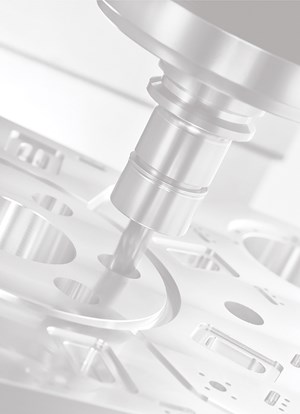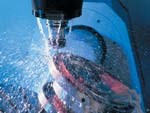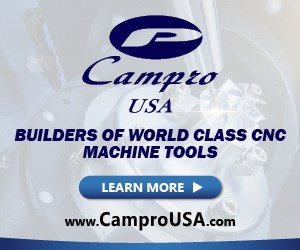High Speed In Simultaneous Five-Axis Machining
In mold and die work, simultaneous five-axis machining is a proven technology, as is high speed machining (HSM). High speed simultaneous five-axis machining, however, is still a pioneering development.
Share



In mold and die work, simultaneous five-axis machining is a proven technology, as is high speed machining (HSM). High speed simultaneous five-axis machining, however, is still a pioneering development. Machine tool builder Mikron (headquarters in Biel, Switzerland, with Mikron Bostomatic in Milford, Massachusetts, as its U.S. arm) has made a major thrust into this frontier with its new HSM 400 U machining center. The company is calling it the first machine capable of five-axis simultaneous machining in a "truly high speed mode." The breakthrough, the company claims, is in the design of its rotational axes. The axes, which tilt and swivel the workpiece under the main spindle head, have the speed and acceleration to match that of the X, Y and Z axes.
Three-axis high speed machining allows a small diameter tool to remove even hardened material efficiently by taking light cuts at high feed rates. However, small diameter tools cannot be very long because tool deflection soon diminishes dimensional accuracy. Short tools, although stiffer, create clearance problems, especially when trying to reach down low on the sidewalls of mold cores or male dies when the machine is limited to three axes. One way to overcome this limitation is to add the fourth and fifth axes so that the cutter can make moves at variable angles.
Unfortunately, conventional rotary axes either above the workpiece in the spindle head or below the workpiece in a rotary table usually lack the rigidity, positioning speed and acceleration rates necessary for HSM. Low rates of acceleration and deceleration have been an especially frustrating drawback when machining small details on molds and dies. Because the tool must change direction so often, the cutter rarely reaches the feed rates at which the main benefits of HSM kick in, so to speak.
The key for Mikron was designing and building rotary axes capable of speeds as high as 25 times those of conventional rotary tables. The HSM 400 U appears to have met this goal. The swiveling B axis has a range of ±110 degrees and is shown at one extreme of its range in the photo on page 60. It can swivel at a top speed of 150 rpm. The rotary C axis inside this swiveling head can rotate at 250 rpm. These axes are powered by liquid cooled direct drive motors, which can accelerate at 100 radians per second2 in B and 300 radians per second2 in C, or 10 times faster than previously possible, the builder claims. (For reference, the typical rotary table accelerates at 10 to 20 radians per second2.) High acceleration is required to maintain constant load on the cutter for the sake of tool life and surface finish.
The bed and column are built as a one-piece polymer concrete "portal" for stiffness and damping qualities. This design puts most of the machine's mass in non-moving parts, allowing the moving axes supported by this structure to have minimum mass. Heat sources associated with the linear axes can also be isolated. The X, Y and Z axes are equipped with high-end glass scales to ensure positional accuracy. Direct measurement systems are also used on the B and C axes. Five-axis machining puts intense computational demands on the control unit, so a high-end control unit is essential. In this case, the Heidenhain iTNC530 is offered.
Other important specs include a 25 kg weight limit on the workpiece; and X, Y and Z travels of 400 mm, 240 mm and 350 mm respectively. Built-in automation in the form of a 20-position pallet changer is standard. Wet or dry machining is possible, and the machine is highly suitable for milling graphite electrodes.The curved enclosure door can be opened with one hand to access both the front and side of the work zone.
Related Content
How to Build Out a Machine Shop for Submarine Parts
Five-axis large-format machining has given Granite State Manufacturing the ability to take on complex submarine parts — and has also worked as a recruiting tool for experienced machinists.
Read MoreHow to Succeed as a Small Swiss Shop: Top Shops 2025
Can small shops succeed with advanced machine tools and software? If so, how do they do it? Read on to learn the strategies that have helped Midway Swiss Turn, our 2025 Top Shops Honoree in Shopfloor Practices, thrive.
Read MoreHow a Family-Owned Tooling Company Competes with Global Giants (Includes Video)
Not ready to go digital? Consider this: With Siemens NX ecosystem, precision shop D’Andrea cut its programming time by 50% and is able to compete globally—even against industry giants.
Read MoreAerospace Shop Thrives with Five-Axis, AI and a New ERP
Within three years, MSP Manufacturing has grown from only having three-axis mills to being five-axis capable with cobots, AI-powered programming and an overhauled ERP. What kind of benefits do these capabilities bring? Find out in our coverage of MSP Manufacturing.
Read MoreRead Next
OEM Tour Video: Lean Manufacturing for Measurement and Metrology
How can a facility that requires manual work for some long-standing parts be made more efficient? Join us as we look inside The L. S. Starrett Company’s headquarters in Athol, Massachusetts, and see how this long-established OEM is updating its processes.
Read More.png;maxWidth=728;quality=90)
















-02.jpg;maxWidth=300;quality=90)










